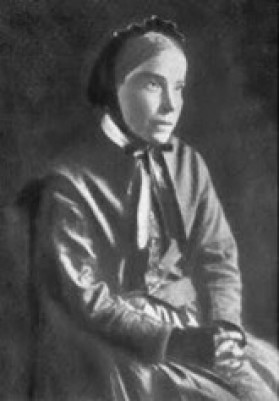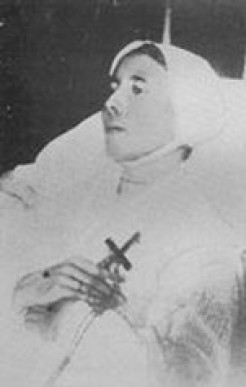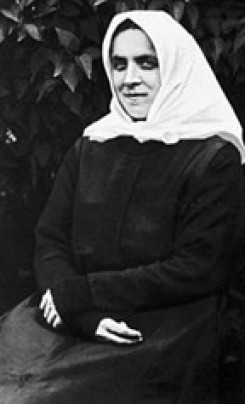New forms of female mysticism in the 19th century
Who were the stigmatics and what do they say?
The stigmatisations of the period referred to in this course were essentially of females, even though it is important to note that the first recognised cases in the history of the Church more often concerned men – Francis of Assisi[1] and Padre Pio[2] . These mystical manifestations are in no way exceptional when we consider that there were more than a hundred cases in the 20th century. The personalities most covered in the media were, in chronological order: [3]Louise Lateau (1850-1883)[4] , [5] Marie-Julie Jahenny (1850-1941)[6] , Marie-Thérèse Noblet (1889-1930), Therese Neumann (1898-1962) [7], and Marthe Robin (1902-1981). We will concentrate on the first two, who were contemporaries, Louise Lateau and Marie-Julie Jahenny, one in Bois-d'Haisne in Belgium, and the other in Blain, near Nantes, who had many biographical elements in common. They were both born in 1850 into Catholic families and joined the Franciscan Third Order[8] , and they both presented a number of stigmata in their lives. Unlike the stigmatics of the 17th century whose symptoms spread from one convent to another, the stigmatics at the end of the 19th century were not cloistered, although they sometimes expressed a wish to be so. Both women had a sickly childhood (cholera, smallpox) which was also traumatic (family deaths), biographical events which were especially emphasised by witnesses at the time, as it was impossible to think of the status of these women other than through the lens of their misfortune. It is true that stigmatisation is seen as endless atonement . But one can also see in these moments of spectacular 'manipulation' of death and blood as much a mode of expression for a female subject dominated by religious discourse as by medical discourse. As such, the experience of stigmatisation is linked to the experience of hysteria, where medical presentation is not independent of wider considerations, as is shown by the case of Nanette Laroux studied by Jan Goldstein.
The spectacle of stigmatisation
The sources bear witness to the importance of the crowds which gathered around the spectacle of mysticism. The local press of Nantes describes thousands of pilgrims running through the fields, breaking through fences, waiting for hours to view the miracle. Marie-Julie, in a state of semi-consciousness, her eyes open, responds to her mother's and sister's questions and shows her wounds. The media are however divided on the nature of the phenomenon and its ultimate political and spiritual message. While the religious press is sparing in its praise, the anticlerical press is clearly critical . This spectacle came from nowhere. The photos taken of the interior of the house show that Marie-Julie Jahenny was inspired by models of other stigmatics whose stories were then circulating in the European press. When Maria von Mörl[9] died in 1868, Louise Lateau began her ecstasies; Marie-Julie Jahenny then took an existing model and transmitted it to her disciples. After 1873, the phenomenon expanded in France: first in the diocese of Nantes, then in the diocese of Angers and in Eure-et-Loir, there was an explosion in the number of stigmatics, most of whom were pale imitations of their models and who were of little interest to the press.
Why did mysticism blossom in the years 1870-1880?
The spectacular reception of the recurrent stigmatisations in this period shows a kind of expectation on the part of the faithful. In troubled times for the Church, weakened by the political and cultural context, divided amongst the bishops, the stigmatics played a role in speaking for the people and consoling them, making sense of the times. They were not alone. Apparitions[10] , possessions[11] , miraculous recoveries[12] .....the 19th century was a time of religious vitality and dynamism from believers. After the challenges of the previous decades, the Catholic Church found itself on the threshold of a secularisation stemming from the French Revolution, the sudden loss of temporal power by Rome, a process of secularisation which was still limited but which encroached on the essential arenas of clerical power. Spectacular demonstrations of belief were often a reaction to the painful withdrawal of religion to the sphere of the individual. Popular devotion proliferated with elements of 'panic', prophetic, mystical and apocalyptic, coming to the fore as the confrontation between Catholicism and the modern world became critical. Thus the faithful were waiting for signs, especially in the political environment of the 1870's. For example, influenced by the legitimist[13] network in the west, Marie Julie Jahenny, endowed with prophetic gifts, announced the coming of Henri V, the comte de Chambord[14] , last legitimate pretender of the Bourbon dynasty, deposed after the fall of Charles X[15] . But one can also consider the proliferation of stigmatics as a sign of a mutation of Catholic piety, a piety becoming more affective, less intellectualised, and which was perhaps going through a 'feminine phase' in the Church, whose regular worshippers were from then on and lastingly marked by feminisation.












